Abstract
We examined the effectiveness of a contingency management program in preventing relapse to illicit opiate use and increasing treatment retention during outpatient methadone detoxification treatment. Twenty male opiate addicts were randomly assigned to an experimental or control group. Following a 3-week methadone stabilization period, men in both groups received identical gradual methadone dose reductions during Weeks 4 through 9 and were maintained on placebo during Weeks 10 through 13. Beginning in Week 4, control patients received $5.00 for providing a specimen twice weekly. Experimental patients received $10.00 and a take home methadone dose for each opiate-free urine specimen but forfeited the incentives and participated in more intensive clinic procedures when specimens were opiate positive. The contingency management procedure slowed the rate of relapse to illicit opiate use. Experimental patients provided significantly more opiate-free urines during the methadone dose reduction in Weeks 4 through 9 than control patients, although the difference between groups was no longer significant during placebo administration in Weeks 10 through 13. In addition, the contingency management program improved treatment retention and reduced symptom complaints during the detoxification. The usefulness and limitations of contingency management procedures for outpatient methadone detoxification are discussed.
Full text
PDF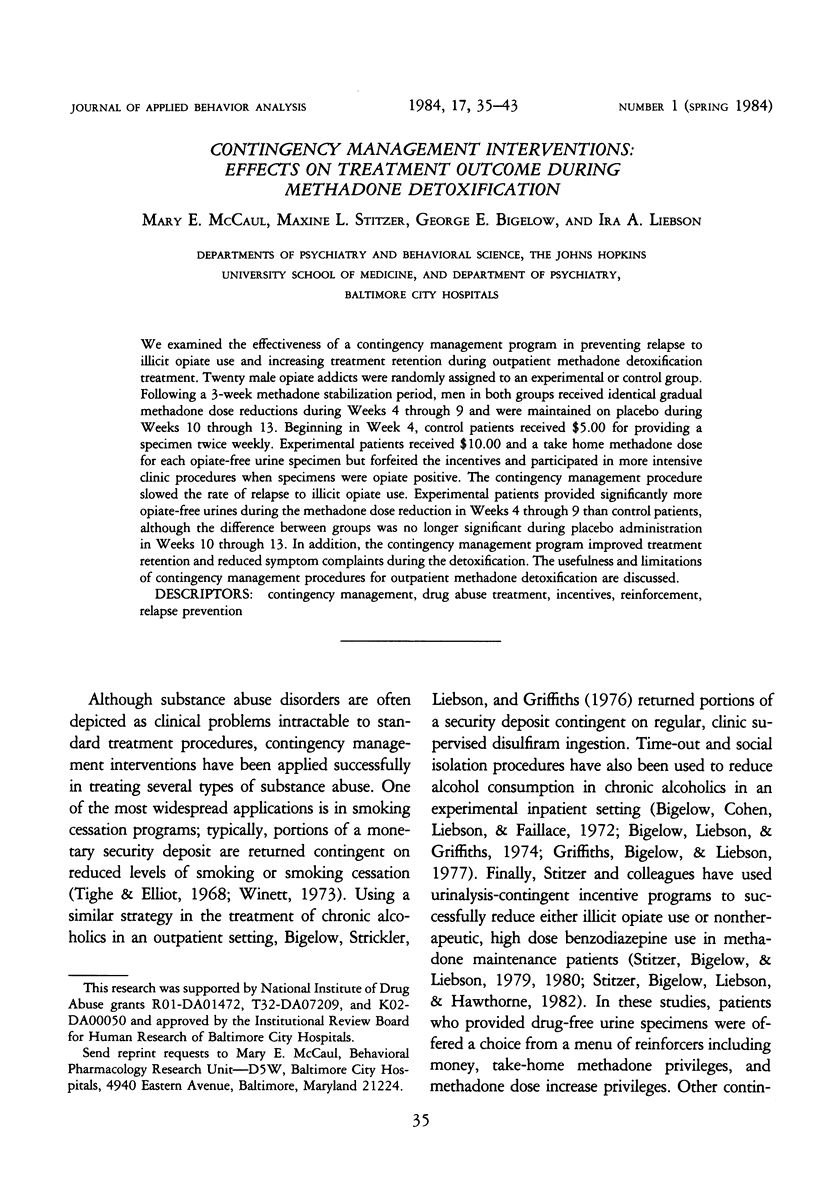




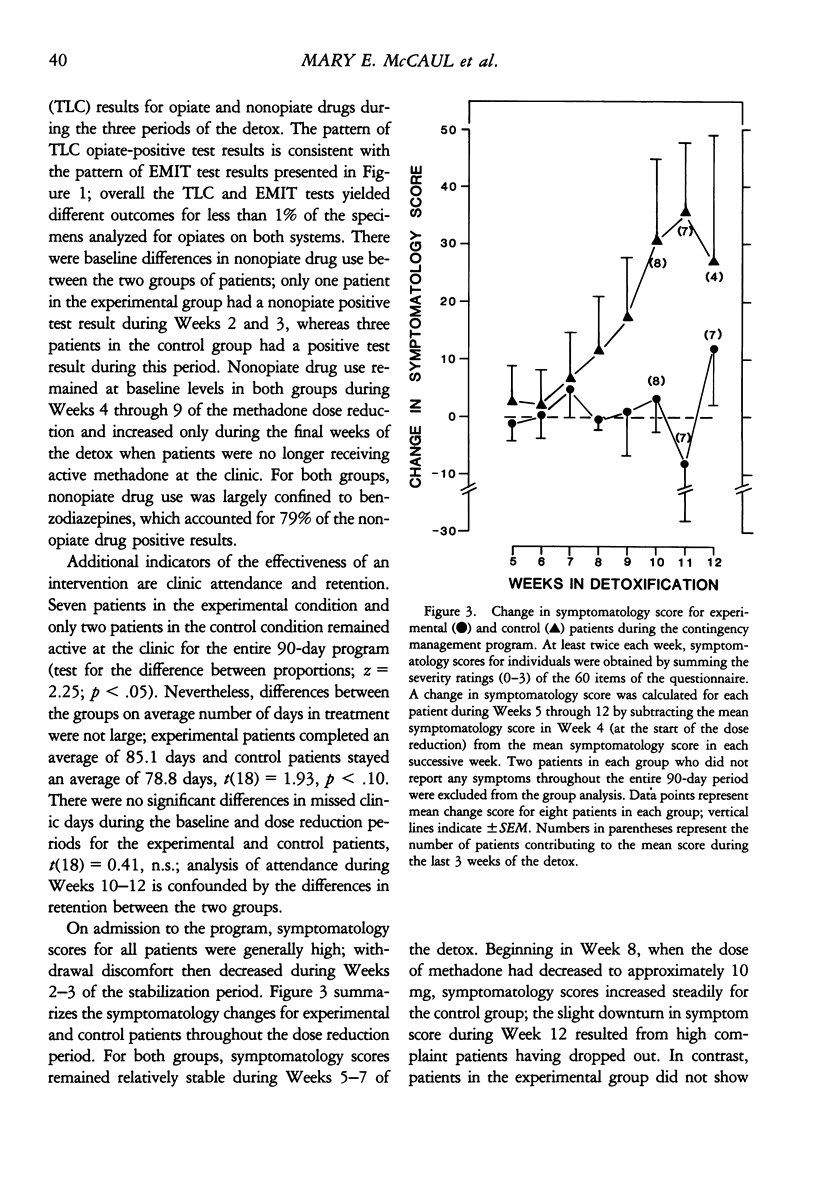
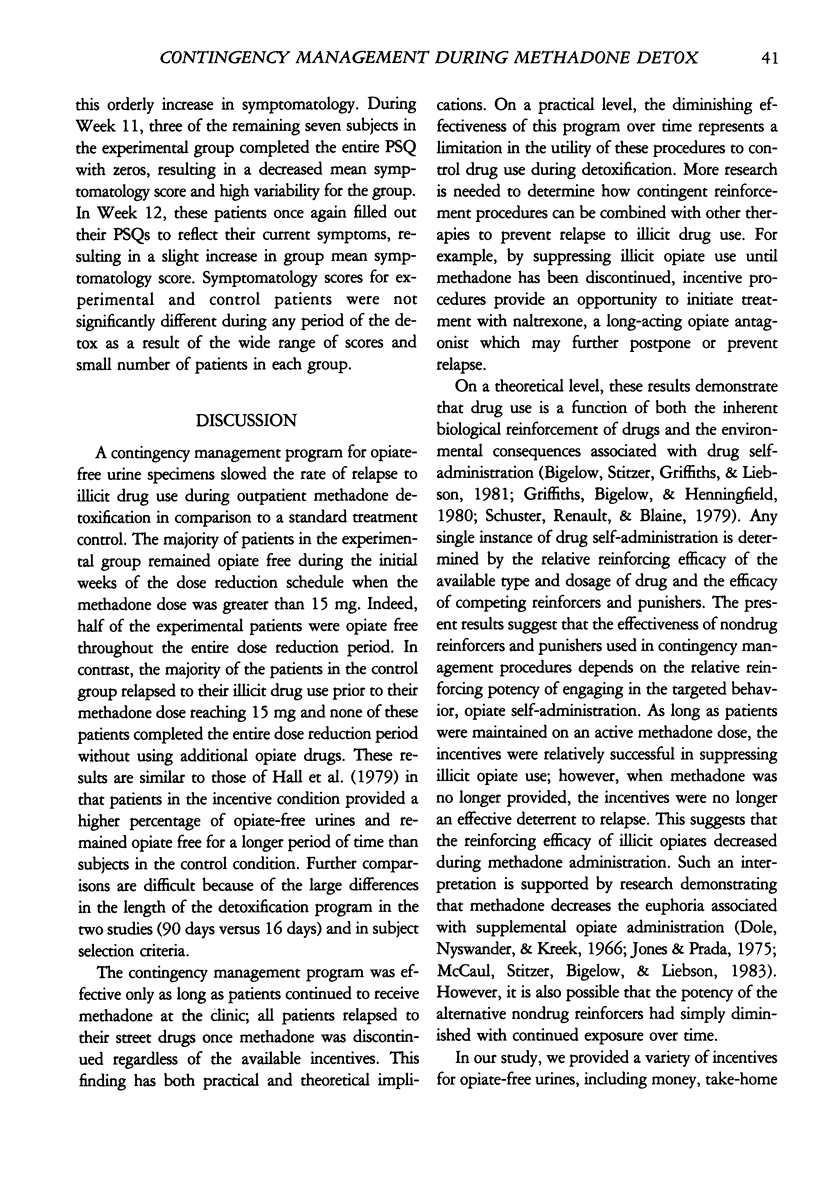
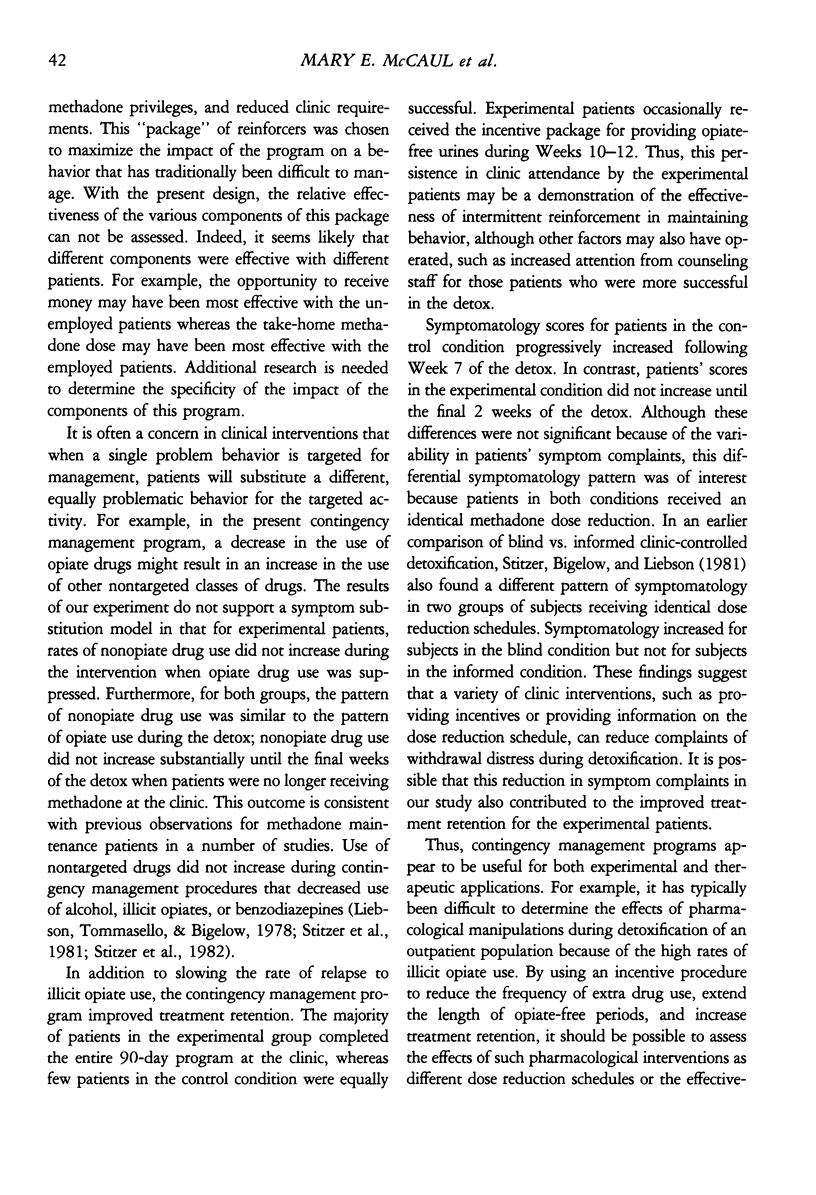
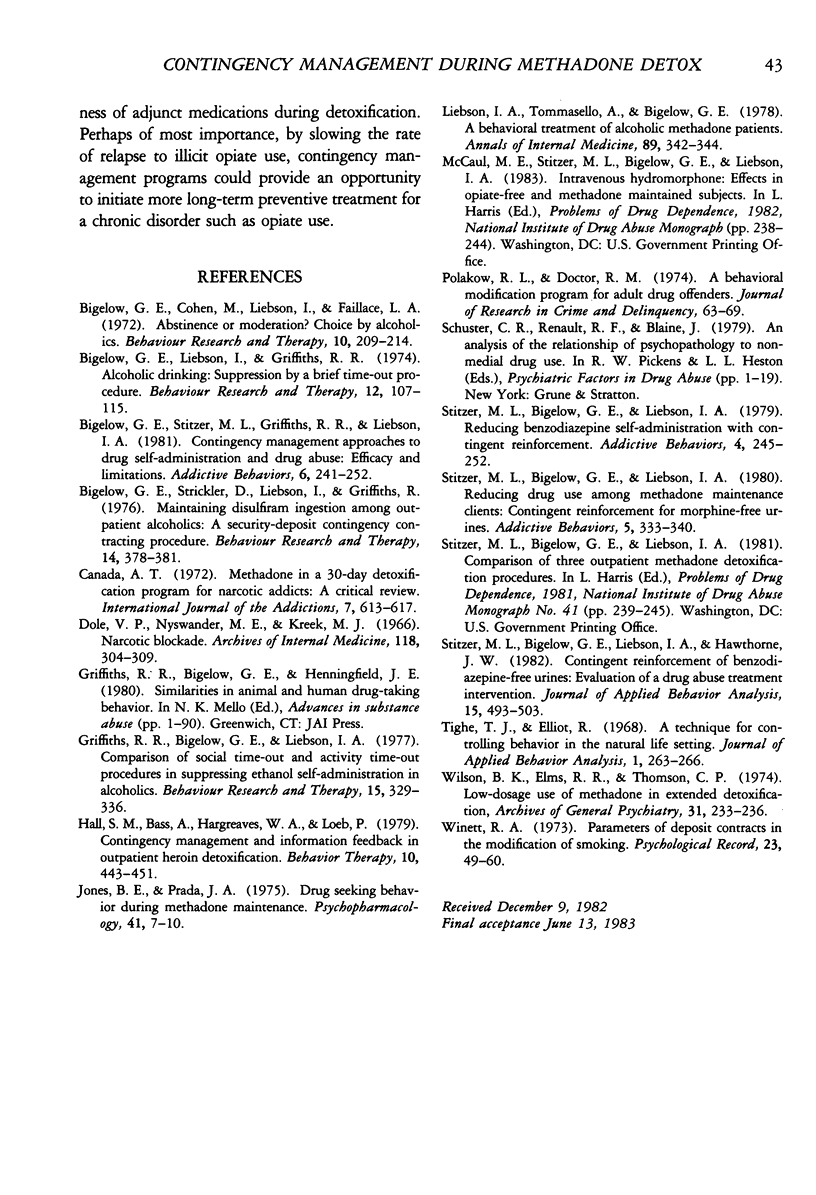
Selected References
These references are in PubMed. This may not be the complete list of references from this article.
- Bigelow G. E., Stitzer M. L., Griffiths R. R., Liebson I. A. Contingency management approaches to drug self-administration and drug abuse: efficacy and limitations. Addict Behav. 1981;6(3):241–252. doi: 10.1016/0306-4603(81)90022-8. [DOI] [PubMed] [Google Scholar]
- Bigelow G., Cohen M., Liebson I., Faillace L. A. Abstinence or moderation? Choice by alcoholics. Behav Res Ther. 1972 Aug;10(3):209–214. doi: 10.1016/0005-7967(72)90037-x. [DOI] [PubMed] [Google Scholar]
- Bigelow G., Liebson I., Griffiths H. Alcoholic drinking: suppression by a brief time-out procedure. Behav Res Ther. 1974 May;12(2):107–115. doi: 10.1016/0005-7967(74)90099-0. [DOI] [PubMed] [Google Scholar]
- Bigelow G., Strickler D., Liebson I., Griffiths R. Maintaining disulfiram ingestion among outpatient alcoholics: a security-deposit contingency contracting procedure. Behav Res Ther. 1976;14(5):378–381. doi: 10.1016/0005-7967(76)90028-0. [DOI] [PubMed] [Google Scholar]
- Canada A. T., Jr Methadone in a 30-day detoxification program for narcotic addicts: a critical review. Int J Addict. 1972;7(4):613–617. doi: 10.3109/10826087209028114. [DOI] [PubMed] [Google Scholar]
- Dole V. P., Nyswander M. E., Kreek M. J. Narcotic blockade. Arch Intern Med. 1966 Oct;118(4):304–309. [PubMed] [Google Scholar]
- Griffiths R. R., Bigelow G., Liebson I. Comparison of social time-out and activity time-out procedures in supressing ethanol self-administration in alcoholics. Behav Res Ther. 1977;15(4):329–336. doi: 10.1016/0005-7967(77)90064-x. [DOI] [PubMed] [Google Scholar]
- Jones B. E., Prada J. A. Drug-seeking behavior during methadone maintenance. Psychopharmacologia. 1975;41(1):7–10. doi: 10.1007/BF00421297. [DOI] [PubMed] [Google Scholar]
- Liebson I. A., Tommasello A., Bigelow G. E. A behavioral treatment of alcoholic methadone patients. Ann Intern Med. 1978 Sep;89(3):342–344. doi: 10.7326/0003-4819-89-3-342. [DOI] [PubMed] [Google Scholar]
- Stitzer M. L., Bigelow G. E., Liebson I. A. Comparison of three outpatient methadone detoxification procedures. NIDA Res Monogr. 1982 Apr;41:239–245. [PubMed] [Google Scholar]
- Stitzer M. L., Bigelow G. E., Liebson I. A., Hawthorne J. W. Contingent reinforcement for benzodiazepine-free urines: evaluation of a drug abuse treatment intervention. J Appl Behav Anal. 1982 Winter;15(4):493–503. doi: 10.1901/jaba.1982.15-493. [DOI] [PMC free article] [PubMed] [Google Scholar]
- Stitzer M. L., Bigelow G. E., Liebson I. Reducing benzodiazepine self-administration with contingent reinforcement. Addict Behav. 1979;4(3):245–252. doi: 10.1016/0306-4603(79)90034-0. [DOI] [PubMed] [Google Scholar]
- Stitzer M. L., Bigelow G. E., Liebson I. Reducing drug use among methadone maintenance clients: contingent reinforcement for morphine-free urines. Addict Behav. 1980;5(4):333–340. doi: 10.1016/0306-4603(80)90007-6. [DOI] [PubMed] [Google Scholar]
- Tighe T. J., Elliott R. A technique for controlling behavior in natural life settings. J Appl Behav Anal. 1968 Fall;1(3):263–266. doi: 10.1901/jaba.1968.1-263. [DOI] [PMC free article] [PubMed] [Google Scholar]
- Wilson B. K., Elms R. R., Thomson C. P. Low-dosage use of methadone in extended detoxification: An experimental comparison. Arch Gen Psychiatry. 1974 Aug;31(2):233–236. doi: 10.1001/archpsyc.1974.01760140081014. [DOI] [PubMed] [Google Scholar]


